A lot can change in a thousand years. So, when the Asian Art Museum asked us to depict over a millennium of Chinese history with a video installation, we saw it as a chance to start thinking on a fresh time scale.
Earlier this year we teamed up with our friends at the San Francisco museum in anticipation of their current exhibition Emperors’ Treasures. In this exhibit, exquisite artworks and personal possessions are on display, passed down throughout many dynasties of Chinese history dating back as far as 960 C.E. We begin with the Northern Song dynasty ruled by Emperor Huizong, a master calligrapher. Ultimately we reach the end of the Qing dynasty marked by the Last Emperor renouncing the throne.

We learn of voyages, battles, advances in technology and changing artistic styles, through a quilt of stories and objects. These priceless artifacts—fragments of history that span hundreds of years and thousands of miles—paint a picture of one of the most advanced civilizations in the world. Yet on their own they don’t create an objective account of the region’s history. This is where modern storytelling makes it possible to take a step back in space and time, to bridge the gaps and communicate a sense of scale.
Across three monitors on the main floor of the exhibit, a massive map animates to display political changes across the geography of eastern Asia. Meanwhile, important events are depicted through text, images and video clips as a needle indicates the year in our thousand-year timeline. Images of familiar paintings and objects appear across the timeline, allowing visitors to relate the prized artifacts they’ve seen in the museum to a real-world place and a moment in time.
Exploring history can be amazing when you merge the subjective with the objective: when we present things from a ground level as well as a bird’s eye perspective. Plan your visit to the Asian Art Museum here, and immerse yourself in some of the most amazing collections in the world.
